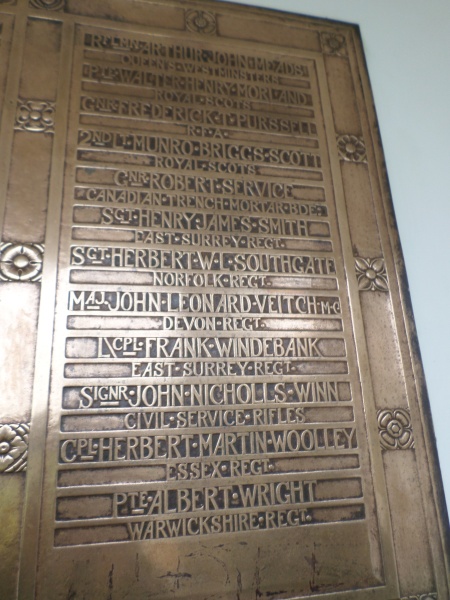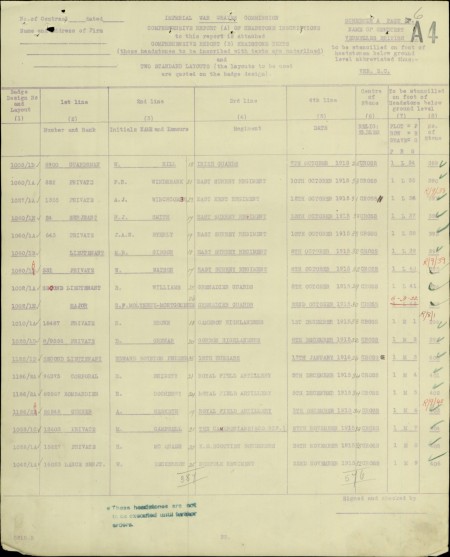
Frank Windebank and Henry Smith remembered on the Kew Botanic Gardens WW1 section Kew Gardens staff memorial (Image Source: Mark Norris, World War Zoo gardens project, Newquay Zoo)
Pony Boy and Garden Labourer: Two Kew Gardens staff from the same regiment were killed in the closing days of the 1915 Battle of Loos.
31. Henry James Smith, 10 October 1915
Serjeant Henry James Smith, Service number 24, 7th Battalon, East Surrey Regiment, 10 October 1915, aged 37. He is buried at Grave Reference I. L. 37, Vermelles British Cemetery, France.
According to his CWGC record, his headstone has the inscription from his wife “Memory is the only thing that grief can call its own“. The headstone is pictured on the TWGPP website.
During the Battle of Loos, when Smith was killed, Vermelles Chateau was used as a dressing station and Plot I was completed first. Smith and fellow Kewite Frank Windebank are buried a few graves apart with other 7th East Surreys) It was laid out and fenced by the Pioneers of the 1st Gloucesters, and known for a long time as “Gloucester Graveyard“.
Henry is listed as the husband of C. E. Smith, of 6, Enmore Villas, Fourth Cross Rd., Twickenham. He was CSM of the same battalion and regiment as fellow Kewite Frank Windebank, who died the same day. Both are listed as one of “six Members of the labouring staff killed in action” in the Kew Guild Journal 1919 Roll of Honour.
An earlier mention notes:
“Two employees from the Gardens were killed in action in France on the same day, Sergeant H.J. Smith, a garden labourer, and Private F. Windebank, pony boy, both of the East Surrey Regiment”.

Fellow Kewites Henry Smith and pony boy Frank Windebank are buried a few graves apart having died the same day in Vermelles. Source: CWG
Francis Richard or Frank Windebank,10 October 1915
Private (or Lance Corporal) Frank Windebank, 822, 7th Battalion, East Surrey Regiment died 10 October 1915, aged 17. He is buried at Grave Reference I. L 35, Vermelles British Cemetery.
According to his CWGC record, there is no family inscription on his headstone, pictured on the TWGPP project website. The Kew Gardens war memorial plaque (above) lists him as a Lance-Corporal, rather than as a Private.
What makes this particular anniversary interesting is that Vermelles is where a fellow Kewite of the same battalion and regiment CSM Henry James Smith, who died on the same day is buried only two graves along (I.L 37). Described as a ‘pony boy’ amongst the “gangers, labourers and boys” at Kew, Windebank was listed as the son of James and Mary Windebank, of 20, Evelyn Rd., Richmond, Surrey.

Frank Windebank and fellow Kewite Henry Smith both died on the 10th in the same regiment, 7th East Surreys, Vermelles.
H.J.Smith was noted as one of “six Members of the labouring staff killed in action” in the Kew Guild Journal 1919 Roll of Honour. The same journal lists a possible relation, one J. Windebank listed at Kew as a carter who joined up in 1918.
Noting that Windebank was a ‘pony boy’ it was interesting to read that in timeline in the History of Kew by Ray Desmond that in August 1914 “three horses taken by Army.” In 1928 when one of the six Kew horses died, it was replaced by a motor lorry. Kew’s last Shire Horses were replaced by a team of five Suffolk Punch in 1937, both now rare breeds. By 1948 only two horses still worked the grounds, mostly mowing and hauling but being steadily replaced by motor mowers and lorries. Finally in 1961 there is a note that “Horses no longer used in the Gardens”, the year before the last Victorian Wardian cases were used for transporting plant collectors’ precious finds back to Kew.
Smith and Windebank’s regiment The 7th East Surreys were one of several wartime service battalions raised for the duration of the war and one of two who fought (with the 8th Battalion) at Loos in September and October 1915.
http://www.queensroyalsurreys.org.uk/1661to1966/ww1east/ww1east.html
7th (Service) Battalion
This was very local to Kew Gardens as it was formed at Kingston-upon-Thames in August 1914 as part of K1 (Kitchener’s VolunteerArmy No. 1) and came under orders of 37th Brigade in 12th (Eastern) Division. The 7th Moved initially to Purfleet but by November 1914 was in billets in Sandgate. They moved to Albuhera Barracks in Aldershot in February 1915.
Smith and Windebank would most likely have disembarked in France at Boulogne on 2 June 1915.
The 7th Battalion War Diary for the 10th October 1915 lists 2 casualties from shelling – Smith and Windebank?
Click to access ES00719151008.pdf
Frank Windebank and Henry Smith, Kew Gardens staff, remembered.
Posted by Mark Norris, World War Zoo Gardens Project, Newquay Zoo

Leave a comment